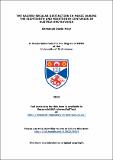The sacred–secular distinction in music during the eighteenth and nineteenth centuries in Austria and Bavaria
Abstract
This thesis explores the sacred–secular distinction in the musical life of Austria and Bavaria during the eighteenth and nineteenth century with particular focus on its legitimacy and feasibility. It examines the attempts made by Joseph II of Austria to separate sacred and secular sphere by banning secular music from the church and finds them to have failed. Joseph’s endeavours are compared to those of the Cecilian Movement, which, although similar in their aim, are found to be motivated very differently, yet equally unsuccessful. A study of the rise of the public concert and choral societies points towards new loci for secular music as well as the spiritual experience of music. Finally Anton Bruckner is discussed as an example for filling old and new loci with a successful synthesis of sacred and secular, both in his lived life and his musical composition. Bringing sacred and secular together conforms to the natural state of Christian life in the world and bears the potential for mutual benefit which outweighs the presumed advantages of distinct lines of separation.
Type
Thesis, MPhil Master of Philosophy
Items in the St Andrews Research Repository are protected by copyright, with all rights reserved, unless otherwise indicated.
Related items
Showing items related by title, author, creator and subject.
-
The culture of music printing in sixteenth-century Augsburg
Roper, Amelie (University of St Andrews, 2017-06) - ThesisIn the early sixteenth century, the free imperial city of Augsburg in southern Germany played a vital role in the development of music printing with movable type north of the Alps. These technical advances impacted on ... -
Reinforcing archaism : the role of musical settings in the history and meaning of the Book of Common Prayer
Sexton, Ian Richard (University of St Andrews, 2020-11-30) - ThesisThe Book of Common Prayer (BCP) is more than four hundred and fifty years old and part of the very fabric of Anglicanism throughout the world. It has a vast catalogue of musical repertory, both in the form of settings of ... -
Composing Christ’s Passion : musical and theological approaches in the Passion settings by James MacMillan, Arvo Pärt, and John Adams
Moerman, Sarah M. (2022-11-30) - ThesisThis thesis provides an account of the differing theologies and compositional approaches of three composers—James MacMillan, Arvo Pärt, and John Adams—and contributes a comparative theological and musical analysis of their ...

